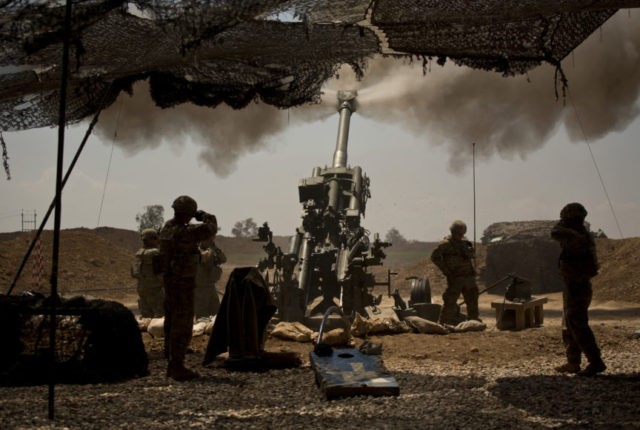WASHINGTON, DC — The security situation in Afghanistan will only “deteriorate modestly this year” in the face of terrorism at the hands of Taliban narco-jihadists, among other factors driving instability in the war-ravaged country, predicted the U.S. intelligence community in its annual Worldwide Threat Assessment.
Meanwhile, Islamabad will continue to harbor terrorist groups on Pakistani soil who are fighting American troops and their allies in neighboring Afghanistan despite U.S. President Donald Trump’s decision to suspend nearly $2 billion in security funding to Pakistan over its reluctance to stop providing sanctuary to jihadists, the U.S .intelligence community also forecasted.
The warnings came during a Senate Select Committee on Intelligence hearing Tuesday focused on the newly unveiled assessment prepared by the Director of National Intelligence (DNI) Daniel Coats.
In the global threat analysis, the American intelligence community notes:
The overall situation in Afghanistan probably will deteriorate modestly this year in the face of persistent political instability, sustained attacks by the Taliban-led insurgency, unsteady Afghan National Security Forces (ANSF) performance, and chronic financial shortfalls.
The National Unity Government probably will struggle to hold long-delayed parliamentary elections, currently scheduled for July 2018, and to prepare for a presidential election in 2019. The ANSF probably will maintain control of most major population centers with coalition force support, but the intensity and geographic scope of Taliban activities will put those centers under continued strain.
Moreover, the American intelligence analysts noted that economic growth in Afghanistan would “stagnate,” prompting Kabul to remain reliant on international funding, which largely originates in the U.S.
The United States is projected to spend an estimated $45 billion on the Afghanistan war this year, bringing total spending since the war started in October 2001 to more than $877 billion.
Notwithstanding the hundreds of billions in U.S. taxpayer funds devoted to the war in addition to the more than 2,260 American military fatalities and nearly 20,290 injuries, the Afghanistan-Pakistan region is home to the “highest concentration” of terrorist groups in the world, the Pentagon has repeatedly stressed.
According to the U.S. military, terrorist groups, primarily the Taliban, controlled or contested about 45 percent of Afghanistan as of October 2017, marking a slight increase from where the group’s reach stood in August 2017.
The release of the annual Worldwide Threat Assessment comes soon after the No. 2 at the U.S. State Department told American lawmakers that President Trump’s Afghanistan war strategy unveiled in August 2017 is starting to bear fruit.
“[T]he President’s South Asia strategy is showing some signs of progress,” John Sullivan, the Deputy Secretary of State, told the Senate Foreign Relations Committee earlier this month. “On the battlefield, we are seeing the Taliban’s momentum begin to slow.”
Randall Schriver, a top Pentagon official who testified alongside Sullivan, conceded that the United States is “clearly not where we want to be,” noting that there have been “Taliban gains” in rural areas in Afghanistan.
More than 16 years after the United States launched military operations in Afghanistan in response to the 9/11 attacks, the Taliban’s ally al-Qaeda remains a threat in the region, also notes the analysis.
The significant uptick in American military operations and the record number of airstrikes under President Trump have failed to translate into gains for the Afghan government, the U.S. Special Inspector General for Afghanistan Reconstruction (SIGAR), a watchdog agency, argues in its latest assessment prepared for Congress.
Echoing the U.S. intelligence community’s findings, Schriver told lawmakers Islamabad has failed to take decisive action against terrorist organizations planning attacks on Afghan territory from Pakistan despite the level of pressure the Trump administration is applying on Islamabad.
The intelligence assessment points out:
Pakistan will continue to threaten U.S. interests by deploying new nuclear weapons capabilities, maintaining its ties to militants, restricting counterterrorism cooperation, and drawing closer to China.
Militant groups supported by Islamabad will continue to take advantage of their safe haven in Pakistan to plan and conduct attacks in India and Afghanistan, including against U.S. interests. Pakistan’s perception of its eroding position relative to India, reinforced by endemic economic weakness and domestic security issues, almost certainly will exacerbate long-held fears of isolation and drive Islamabad’s pursuit of actions that run counter to U.S. goals for the region.
Officials from the Pentagon, Afghanistan, and India have long accused Pakistan of willingly serving as a sanctuary for terrorist groups, something that Islamabad denies.
Pakistan considers China its top ally in South Asia. The Trump administration is promoting counterterrorism cooperation with China in neighboring Afghanistan.
Both China and Pakistan view India as their economic and military enemy, a rivalry that could spell trouble for the United States, acknowledges the Worldwide Threat Assessment.
“Relations between India and Pakistan are likely to remain tense, with continued violence on the Line of Control [LoC] and the risk of escalation if there is another high-profile terrorist attack in India or an uptick in violence on the Line of Control,” caution American intelligence analysts.
The LoC refers to the border that separates the portions of Kashmir respectively controlled by India and Pakistan.
Kashmir is a Muslim-majority Himalayan region claimed by nuclear-armed China, Pakistan, and India.
“We expect relations between India and China to remain tense and possibly to deteriorate further, despite the negotiated settlement to their three-month border standoff in August, elevating the risk of unintentional escalation,” reports the U.S. intelligence community, referring to clashes between the two countries in the Doklam region that sits along the international boundary shared by both nations.

COMMENTS
Please let us know if you're having issues with commenting.